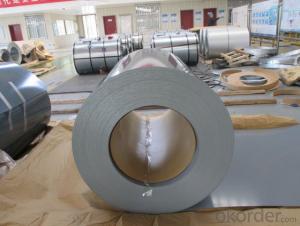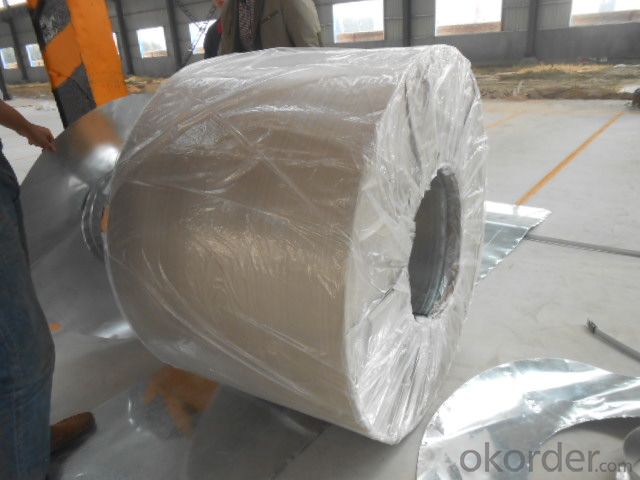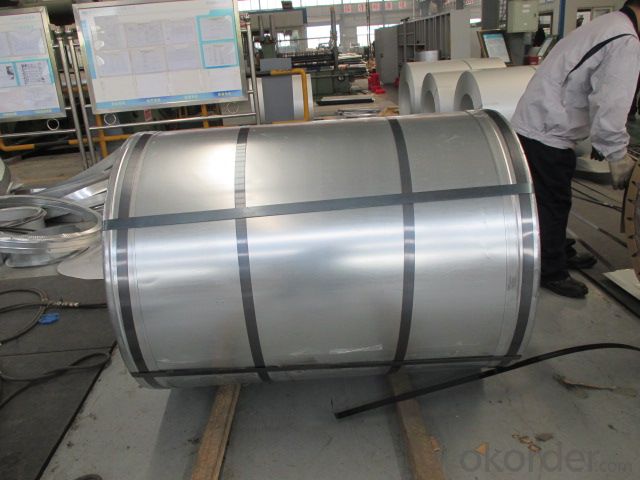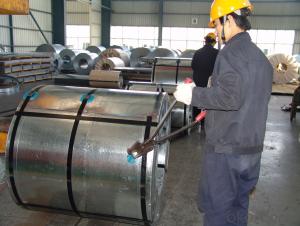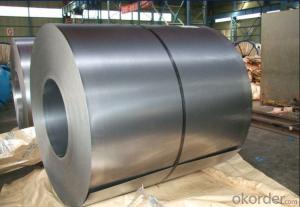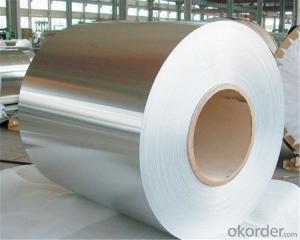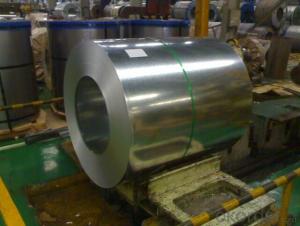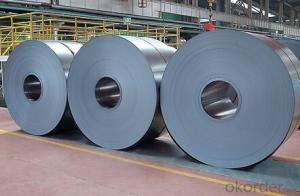GALVANIZED STEEL COILS JIS G 3302 SGCC
- Loading Port:
- China Main Port
- Payment Terms:
- TT OR LC
- Min Order Qty:
- -
- Supply Capability:
- -
OKorder Service Pledge
OKorder Financial Service
You Might Also Like
Prime Galvanized steel coil
Packaging & Delivery
Packaging Detail: seaworthy export package
Delivery Detail: on request
Specifications
1. more than 10 years’ experience on this field
2. advanced equipments
3. competitive price
4. soonest delivery
Product Description :
Commodity
Hot dip galvanized steel coil
Technical Standard:JIS 3302 / ASTM A653 / EN10143/ GB/T 2518
Grade:DX51D/ S250,280,320GD,SGCC,SGHC,SGH340,SGH400,SGH440,G450,G550
Types:Commercial / Drawing / Deep Drawing / Structural quality
Width: 900mm/1000mm/1219mm/1200mm/1220mm/1250mm
Thickness: 0.2mm~4.0mm
Type of coating: galvanized
Zinc coating: Z40-275g/m2,Z40-Z450g/m2
Surface treatment:zero spangle / regular spangle/ big spangle
ID coil: 508mm or 610mm
Coil weight: 3-10/MT per coil
Package:Properly packed for ocean freight exportation in 20''container
Application::home appliances, constructions, building, machineries
Our Advantages :
1. Expertise:
More than 10 years of manufacture: we know how to properly handle every step of production.
2. Competitive price:
We can offer competitive prices to our customers.
3. Accuracy:
We have excellent technicians and leaders, which can ensure our products are exactly what you want.
4. Materials:
All galvanized steel coils are made of high-quality raw materials.
5. Certificate:
Our products are certified by ISO9001.
6. Productivity:
We have large-scales of production lines,, which can guarantee all your orders will be finished in earliest time.
Hr CGL Technical Process:
Coil loading-> uncoiling-> cutting-> welding-> entry accumulator-> Heating and deoxidization-> galvanizing-> air cooling->water quenching-> air dryer-> tension leveler-> Passivation->air dryer->exit accumulator-> oiling-> cutting-> recoiling->coil unloading-> packing
The furnace heating style: improved Sendzimir heating technology
Hourly output: max.76.3t/h
Process after coating: tension leveling, Passivation or oiling
Our Service
Our quality
Test Equipments of Prepainted Galvanized Steel Coil : Salt-spray tester; Atomic absorption spectrophotometer; Rockwell typer hardness tester; Tensile test machine; Metrohm titration; Laboratory Bend test machine.
Our packing
Properly packed for ocean freight exportation in 20''container, galvanized metal fluted rings on inner and outer edges, galvanized metal & waterproof paper wall protection disk, galvanized metal & waterproof paper around circumference.
R&D department
R&D department concentrates on researching and developing reliable products with best quality. The quality department test and control every process of production to guarantee the best quality of products
- Q: Iron too heavy for Ulysses but if there was any iron used id imagine it was steel. Can steel go deeper into sun than iron? Compare two bolts.. 1steel 1iron..is there a difference to what the steel can do?
- Dont understand are you going to put them in sun ? Sun made from gas wich is on fire. Its impossible to get to the sun and not to get burn. Steel is really more solid and strong than iron so its more hard to break it or to bend. But in camparing of fusion temperature - iron is a bit more better, though it would not make a big difference .From metals - tungsten has the highest fusion temperature - near to 3400 C . Iron is near to 1530 C, steel is near to 1300 -1500 C. So according to this tungsten can go most close to sun. Right near the sun temperature is millions of degrees so anything will fuse and burn there.
- Q: I'm writing a story, and trying to find out how hot it needs to be for steel to turn into a gas.
- Steel is to broad. There are many types of steel with different melting/boiling points. Iron* has a boiling point of 5182 °F and a Heat of vaporization of 340 kJ·mol?1. iron is the main ingredient of steel, along with carbon and other various elements.
- Q: What are the different types of steel coil cutting methods?
- There are several different types of steel coil cutting methods, including shearing, slitting, and laser cutting. Shearing involves using a straight blade to cut through the coil, while slitting involves using circular blades to make multiple cuts. Laser cutting is a more precise method that uses a laser beam to cut through the coil. Each method has its advantages and is chosen based on the specific requirements of the project.
- Q: What are the common methods of packaging steel coils for international shipping?
- The common methods of packaging steel coils for international shipping include using wooden crates or pallets, securing the coils with metal or plastic strapping, using moisture-resistant packaging materials, such as plastic or shrink wrap, and adding dunnage or cushioning materials to prevent movement or damage during transit. Additionally, steel coils may be packed in containers or onto flat racks for optimal stability and protection.
- Q: I have heartgold and I don't have a steel type Pokemon to beat lapras. HELP
- There are many steel types in Heartgold and Soullsilver. Thing is, lapras is also a water type so steel is not super effective against it. The super effective types against lapras are Grass, electric, fighting, and rock. Lapras has very high HP and special defence. Plus, since it is hailing, Blizzard gets 100% accuracy. Since grass is weak against ice, it's not the best choice. I would go with a Machamp with No guard and Dynamic Punch (for 100% accuracy). Fighting would be the best type becuase rock is weak to water and grass is weak to ice and electric pokemon don't have the best stats. You could use Raikou but i wouldn't. If you still want steel types, Magnezone and Steelix are good. So are Agron and Empoleon. Hope i helped!!!
- Q: Can steel coils be coated with anti-graffiti materials?
- Yes, steel coils can be coated with anti-graffiti materials. These materials create a protective layer that can prevent graffiti from adhering to the surface, making it easier to remove any unwanted markings.
- Q: How are steel coils used in the manufacturing of steering columns?
- Steel coils are used in the manufacturing of steering columns as they provide the necessary strength and durability required for this crucial automobile component. The steel coils are formed into specific shapes and sizes, which are then used to create the structural framework of the steering column. This ensures that the steering column can withstand the forces and stresses encountered during vehicle operation, allowing for safe and reliable steering control.
- Q: I am building a robot for Bots IQ. In doing so i have the option of building the the armor of my robot out of titanium or tool steel.. which would be the better option.Brief description of Bots IQ: It is a competition where 2 15lb robots go and attack each other with spinning blades, hammers or whatever is designed.
- I would have to say titanium , but in doing so I am having to assume you have access to some very serious machinery.This is because Ti is extremely difficult to work and also work hardens, which could lead to cracking and failure.The other problem is that Ti is also very hard to weld .It seems tool steel is the choice for ease of working and weldability, so unless you can buy the bits you need precut or made then I'd say tool steel,preferably something along the lines of ramax.Your other option is spring steel as this is workable and gets hardened after shaping.
- Q: What is steel made of and what is its molecular weight? It's for a project in chemistry class so if you have a website link as well, that would be great!
- Steel is an alloy consisting mostly of iron with a little Carbon thrown in. Steel is not a molecule, therefore, it does not have a molecular weight. Steel contains atoms of iron and carbon in a crystal lattice, along with various other alloying elements such as manganese, chromium, vanadium, and tungsten.
- Q: What are the trends and developments in the steel coil industry?
- The steel coil industry has witnessed several trends and developments in recent years. These changes have been driven by various factors, including technological advancements, shifts in demand and supply dynamics, and environmental concerns. One significant trend in the steel coil industry is the increasing use of advanced technologies in production processes. Automation and robotics have revolutionized steel coil manufacturing, leading to improved efficiency and quality control. These technologies have also enabled the industry to meet the growing demand for customized steel coils, as they allow for faster and more precise production. Another trend in the industry is the shift towards lightweight and high-strength steel coils. With the rising need for fuel-efficient vehicles, manufacturers are looking for lighter materials that maintain strength and durability. Steel coil producers are developing innovative products that meet these requirements, such as advanced high-strength steels and ultra-high-strength steels. These materials offer improved performance while reducing the weight of the final product. Environmental concerns have also spurred developments in the steel coil industry. There is a growing demand for sustainable and eco-friendly steel coils, which has led to the adoption of greener manufacturing processes. Steel coil manufacturers are increasingly utilizing recycled materials and implementing energy-efficient technologies to reduce carbon emissions and waste generation. Additionally, there is a focus on improving the recyclability of steel coils to minimize the environmental impact throughout their lifecycle. Furthermore, the steel coil industry is witnessing a shift in demand and supply dynamics. Emerging economies, particularly in Asia, are driving the demand for steel coils due to rapid industrialization and urbanization. This has led to increased investments in production capacity in these regions. On the other hand, developed economies are experiencing a trend towards consolidation and specialization, with some companies focusing on niche markets or specific steel coil applications. Overall, the steel coil industry is undergoing significant transformations driven by technological advancements, changing demand patterns, and environmental concerns. These trends and developments are shaping the landscape of the industry, making it more efficient, sustainable, and adaptable to evolving market needs.
Send your message to us
GALVANIZED STEEL COILS JIS G 3302 SGCC
- Loading Port:
- China Main Port
- Payment Terms:
- TT OR LC
- Min Order Qty:
- -
- Supply Capability:
- -
OKorder Service Pledge
OKorder Financial Service
Similar products
Hot products
Hot Searches
Related keywords
